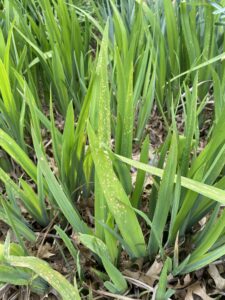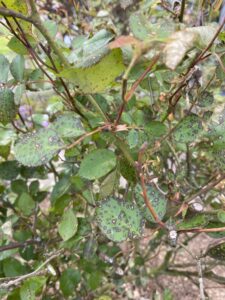 Pesticide drift can occur virtually anywhere — between neighboring farms, farms and residential properties, or neighboring residential properties. Whether it’s a next-door neighbor or a farmer who owns the field adjacent to your property, they have the legal right to apply pesticides to their property or property they lease. However, pesticide applicators also have the legal obligation to keep those products on their side of the property line, and you have the right to not have pesticides drifting onto your property.
Pesticide drift can occur virtually anywhere — between neighboring farms, farms and residential properties, or neighboring residential properties. Whether it’s a next-door neighbor or a farmer who owns the field adjacent to your property, they have the legal right to apply pesticides to their property or property they lease. However, pesticide applicators also have the legal obligation to keep those products on their side of the property line, and you have the right to not have pesticides drifting onto your property.
What Are Signs of Drift? Pesticide drift can harm human health, injure livestock and pets or damage plants and other properties. Here are some things that may occur that should make you consider pesticide drift: 1. You felt a pesticide application spray physically touch you. Direct exposure to pesticides is a serious matter and you should never treat it lightly. If you come in contact with a pesticide, remove your clothing and shower. Retain your clothes in a sealed bag for possible residue testing. Seek medical advice about further actions. 2. You observe distorted or discolored leaves on your trees, landscape or garden plants, or crop plants. 3. You observe spray mist moving onto your property. 4. You notice dead honeybees, dead fish, or areas where vegetation has yellowed or died suddenly.
 Find Out the Cause of Damage It’s easy to blame a neighbor for pesticide drift, but before you act, be sure to take some important steps to determine if the problem you’re experiencing was a result of drift: First, determine if the symptoms you observe were caused by drift or if they were caused by other problems such as insect pests, diseases, salt damage, mowing injury, root compaction or weather-related issues such as drought or cold injury. Purdue Extension county educators can help you determine the cause of the injury symptoms. The educators will look for any possible explanations for the damage, including nutrient deficiencies; insect, weed, and disease problems; improper planting and cultivation practices; and environmental conditions. They may even suggest that you submit a sample to the Purdue Plant & Pest Diagnostic Laboratory where a specialist will examine the sample. To find your Purdue Extension county office call 888-EXT-INFO or go to www.extension.purdue.edu/about#counties.
Find Out the Cause of Damage It’s easy to blame a neighbor for pesticide drift, but before you act, be sure to take some important steps to determine if the problem you’re experiencing was a result of drift: First, determine if the symptoms you observe were caused by drift or if they were caused by other problems such as insect pests, diseases, salt damage, mowing injury, root compaction or weather-related issues such as drought or cold injury. Purdue Extension county educators can help you determine the cause of the injury symptoms. The educators will look for any possible explanations for the damage, including nutrient deficiencies; insect, weed, and disease problems; improper planting and cultivation practices; and environmental conditions. They may even suggest that you submit a sample to the Purdue Plant & Pest Diagnostic Laboratory where a specialist will examine the sample. To find your Purdue Extension county office call 888-EXT-INFO or go to www.extension.purdue.edu/about#counties.
How you respond to a drift incident depends on many factors, including the extent of injury caused by the drift, the relationship you have with the application business or applicator, and how the company representative responds to your concerns. The choice of what action to take is your responsibility. It is a personal decision and there is no single right or wrong approach. Remember evidence is time sensitive; delaying the filing of your complaint may negatively affect its outcome. Pesticide residues may be difficult or impossible to detect if there is a delay in an investigation.
 The Office of Indiana State Chemist (OISC) is an independent state agency that has the responsibility to investigate pesticide complaints. They investigate complaints at no cost. OISC will only determine if drift occurred and if the applicator violated the product label or Indiana Drift Rule. At the conclusion of the case both the complaining party and the applicator receive a copy of the findings. OISC does not get involved in matters of restitution or compensation for loss. If OISC determines there has been a violation, then you will need to decide if and how you wish to quantify the loss and whether to seek compensation for your loss. You can seek damages directly with the applicator, with insurance companies, or through civil proceedings. To file a complaint with OISC call 765-494-1589 or go to www.oisc.purdue.edu/pesticide/index.html and click on Filing a Pesticide or Fertilizer/Manure Complaint.
The Office of Indiana State Chemist (OISC) is an independent state agency that has the responsibility to investigate pesticide complaints. They investigate complaints at no cost. OISC will only determine if drift occurred and if the applicator violated the product label or Indiana Drift Rule. At the conclusion of the case both the complaining party and the applicator receive a copy of the findings. OISC does not get involved in matters of restitution or compensation for loss. If OISC determines there has been a violation, then you will need to decide if and how you wish to quantify the loss and whether to seek compensation for your loss. You can seek damages directly with the applicator, with insurance companies, or through civil proceedings. To file a complaint with OISC call 765-494-1589 or go to www.oisc.purdue.edu/pesticide/index.html and click on Filing a Pesticide or Fertilizer/Manure Complaint.
This article was excerpted from Purdue Pesticide Programs publication PPP-110, authors Michael O’Donnell, Roy Ballard, Fred Whitford & Joe Becovitz